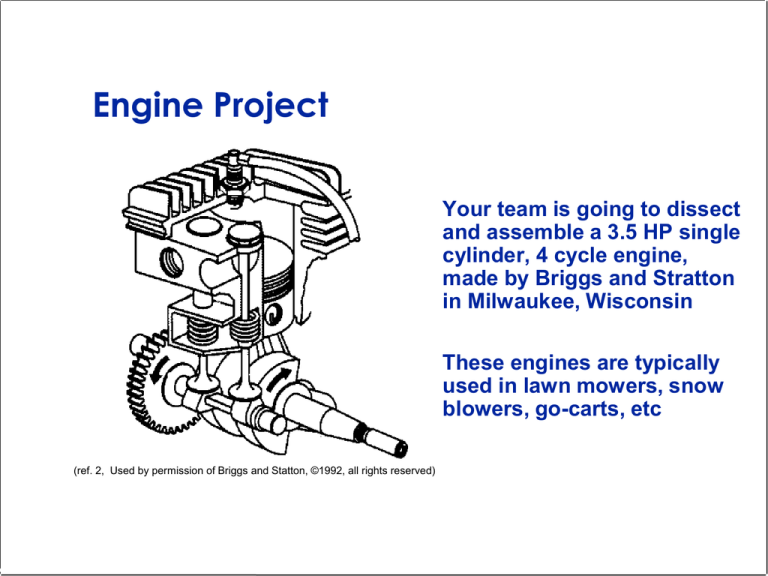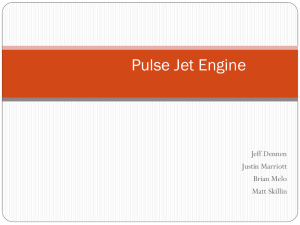
Engine Project
Your team is going to dissect
and assemble a 3.5 HP single
cylinder, 4 cycle engine,
made by Briggs and Stratton
in Milwaukee, Wisconsin
These engines are typically
used in lawn mowers, snow
blowers, go-carts, etc
(ref. 2, Used by permission of Briggs and Statton, ©1992, all rights reserved)
Engine Project
Start engine.
Disassemble engine. (Follow the instruction exactly!)
Review parts and functions – Ask questions!
Answer questions about engines. (group assignment)
Assemble engine.
Re-start engine.
Write individual report on how engines work.
(individual assignment)
What is an engine?
- a machine which converts chemical energy
into mechanical energy
Types of engines:
*External combustion engine.
-Ex: steam engine
Figure source:http://www.tpub.com/machines/12.htm
*Internal combustion engine.
-Ex: car engine
Internal combustion engines
Reciprocating engine
- 4 stroke engine
- 2 stroke engine
Rotary engine
- Wankel engine
- Turbine engine
Reaction engine
- Rocket engine
The very basic of an engine
The ideal gas law: PV = nRT
P: pressure; V: volume; n: mole number; T; temperature
- Gas will expand upon the application of heat.
- The application of heat upon the gas will increase its
pressure (if gas is confined in a volume).
- The compression of the gas will increase its temperature
We try to create heat (through burning) to the gas, so the gas
can push the piston, thereby crank the engine, and output
the movement to useful work.
How engine works?
Exhaust
Air
Mixing
Combustion
Power
Fuel
Useful
Work
•Carburetor
•Ignition
•Valves
•Flywheel
•Crankshaft
4 stroke Cycle
1
Intake Valve
Intake
Manifold
Cylinder
2
Exhaust Valve
Exhaust
Manifold
3
4
Spark
Plug
Piston
Connecting
Rod
Intake Stroke
Intake valve opens,
admitting fuel and air.
Exhaust valve closed
for most of stroke
Crank
Crankcase
Compression Stroke
Both valves closed,
Fuel/air mixture is
compressed by rising
piston. Spark ignites
mixture near end of
stroke.
Power Stroke
Fuel-air mixture burns,
increasing temperature
and pressure, expansion
of combustion gases
drives piston down. Both
valves closed - exhaust
valve opens near end
of stroke
Exhaust Stroke
Exhaust valve open,
exhaust products are
displaced from cylinder.
Intake valve opens
near end of stroke.
1. Intake
2. Compression
3. Power
4. Exhaust
Animation
Questions:
1. How do we have the mixture of fuel and air into
the cylinder?
2. How do we initiate the combustion?
3. Anything else important related to the
combustion?
4. How do we output the work into useful energy?
5. Anything else to notice?
How do we get the mixture of fuel and air?
Venturi-type Carburetor
The carburetor of our engine
Bernoulli Effect:
P+1/2 V2 = Constant
Choke
Venturi
Higher Pressure
Outside Engine
Fuel
Throttle
Venturi-type Carburetor in the car
Air/Fuel Mixture To Engine
Bernoulli Effect:
P+1/2 V2 = Constant
Throttle Plate
Atomized Fuel
Valve Stem
Fuel Inlet
Float
Venturi
Choke Plate
Bowl
Constant level is
maintained in bowl -as
float moves down,
valve stem moves down,
allowing more fuel into
bowl, float moves up and
closes valve
Fuel
Nozzle
Inlet Air
Metering Orifice
Ref. Obert
How do we initiate the combustion?
Image resource:
http://www.nhsnowmobilemuseum.com/burdicksledshed
/1974%20Alouette%20Super%20Brute%20440.htm
But how do we get the spark plug spark?
•Megneto system ( which our engine uses)
•Mechanical ignition
•Electronic ignition
•Engine management system
…………….
Anything else important related to the
combustion?
Think about following situations:
-What will happen if the intake or exhaust valve are not closed
during the compression stroke (just before the power stroke)?
-What will happen if the intake or exhaust valve open during the
power stroke?
These situations are not desirable.
Need solutions to avoid these.
•Solution?
Right timing of the valves.
The valve mechanism.
rocker
Valve Mechanisms:
How you get the right timing
valve
Image from :
push rod
Automotive mechanics, 8th ed. By William H. Crouse
piston
valve lifter
camshaft
cam
crankshaft
Timing marks
So now you think you can prevent all
the leaking from the cylinder?
Piston
Image from:
www.rbracing-rsr.com/ 113orca.htm
darryl.hudson.home.mindspring.com/
ww.eng.iastate.edu/explorer/topics/car/engine.htm
How do we output the work into useful
energy?
Reciprocating to rotary
motion
Crankshaft
Image from :
toyotaperformance.com/crankshaft_kits.htm
Anything else to notice?
Piston, crankshaft,
& fly wheel
Image from:
http://www.eng.iastate.edu/explorer/topics/car/engine.htm
Output
torque
time
Have a better idea
how engines work?
How does the engine complete these Primary Functions?
Hint
Get started?
Suck in fuel/air?
Mix air and fuel?
Ignite the mixture?
Make the work available to somebody?
Exhaust the gases?
Shut off?
Think about the parts and processes involved for each.
Have a better idea
how engines work?
How does the engine complete these Secondary Functions?
Hint
Stay lubricated?
Operate the valves at the right time?
Smooth out the power pulses?
Store the fuel?
Keep cool?
Make it easy to start?
Think about the parts and processes involved for each.





